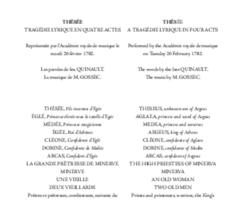Thésée
During his short term of office (1778-1779), Devismes, the director of the Académie Royale de Musique, led the venerable institution in an ambitious direction by commissioning works from the foremost composers of the time and by reviving older operas, like Lully’s Thésée, which he wanted to compare to a new work in order to demonstrate how far modern music had come. He suggested that Gossec write this new version, based on a libretto by Quinault and “rejuvenated” by Morel de Chédeville, who reduced it to four acts and cut a secondary plot, giving greater prominence to the orchestra. Despite a handful of critics, this innovative combination of a Gluckian-style dramaturgy with Italian-style structure and French-style declamation was welcomed, if not enthusiastically, then at least with interest, by audiences and critics, even though this work would probably have been far more successful if it had been performed four years earlier. The lyric tragedy received fifteen performances. Among the best-loved numbers, apart from the king’s aria “Faites grâce à mon âge” (I, 7) lifted from Lully and simply re-orchestrated (which, paradoxically came in for a great deal of praise), the audience responded well to the scenes in which Médée called upon the demons, regarded as some of the finest in the genre. The portrayal of the characters is excellent, as can be seen by the complex figure of Médée, who is appositely drawn. Contemporary accounts focused on the refined beauty of Gossec’s orchestral colours, whose modernity is sometimes overlooked, particularly in the treatment of the winds.
Synopsis
This work, mythological in inspiration, begins as battles are raging around Athens; the priestesses and Princess Églé pray to the goddess Minerva, asking her to protect the city. Égée is victorious. While giving thanks, he makes a confession of love to Églé, whom he wishes to marry despite being betrothed to Médée. However, Églé, like Médée, is in love with Thésée, whom no one knows is Égée’s son. Médée pretends to agree to help the unfortunate lovers but threatens Églé, giving her a glimpse of her demonic powers: she changes the palace into Hell and shows her a vision of Thésée’s dead body. Frightened, Églé agrees to pretend to be cold towards Thésée. Finally she relents, and the two lovers swear eternal love to each other. In the last act, Médée has convinced Égée that he has been betrayed by the young, valiant Thésée and hands him a poisoned chalice to give to Thésée. At the last moment, Églé tells Égée that Thésée is his son. A furious Médée appears on her chariot and threatens to destroy the palace. The goddess Minerva stops her and the Athenians can celebrate their newfound peace.

